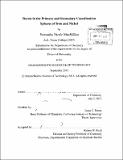| dc.contributor.advisor | Jonas C. Peters. | en_US |
| dc.contributor.author | MacMillan, Samantha Nicole | en_US |
| dc.contributor.other | Massachusetts Institute of Technology. Department of Chemistry. | en_US |
| dc.date.accessioned | 2014-01-23T18:39:52Z | |
| dc.date.available | 2014-01-23T18:39:52Z | |
| dc.date.copyright | 2013 | en_US |
| dc.date.issued | 2013 | en_US |
| dc.identifier.uri | http://hdl.handle.net/1721.1/84375 | |
| dc.description | Thesis (Ph. D.)--Massachusetts Institute of Technology, Dept. of Chemistry, 2013. | en_US |
| dc.description | Cataloged from PDF version of thesis. Page 179 blank. | en_US |
| dc.description | Includes bibliographical references. | en_US |
| dc.description.abstract | Motivated by the reported electronic versatility of anionic tris(phosphine)borate and tris- (phosphine)sily1 ligands, a new, neutral tris(phosphine)borane scaffold was prepared. The synthesis, spectroscopy and solid-state structures of iron complexes ligated by both [pi]-acidic and [pi]-basic moieties are presented. The cationic imido complex, [[TPBPh]FeNAd]- [BAr4] ([TPBPh = (2Ph2PC6H4 )3B, [BAr~] = tetrakis[3,5-bis(trifluoromethyl)phenyl]borate), was generated and the EPR spectroscopic and solid-state structural features described. This complex is unique among the iron tris(phosphine)borane complexes prepared by the Peters group in that there is no interaction between the iron and boron centers. The potential for bifunctional catalysis employing the nickel bis(phosphine)borane complex [MesDPBPh]Ni was explored ([MesDPBPh] = (2-Ph 2PC6H4 )2B(1,3,5-Me 3C6H2)). This species activates E-H bonds (E = Si, Ge, S) and traditionally unstable borohydrido- E nickel complexes were isolated. The solid-state structures of these complexes are described. The catalytic hydrosilylation of para-substituted benzaldehydes was studied and a mechanism for the transformation proposed. An intermediate nickel borohydridosiloxyalkyl species was identified and characterized by NMR spectroscopy. A series of nickel borohydridothiolate complexes was prepared and a rare, nickel(I) borohydridothiolate species was isolated and structurally characterized. The reactivity of the iron(II) alkyl complex [PhBP h]FeMe towards H2 is presented ([PhBP h] = PhB(CH2 PPh2 )j). Exposure of a C6H6 solution of [PhBpPh]FeMe to an excess of H2 results in the formation of a previously described iron 17 5 -cyclohexadienyl complex. Repeating the reaction in THF solution with one equivalent of PMe 2Ph yields the dihydrogen hydride complex [PhBPPh]Fe(H 2)(H)(PMe 2Ph), as determined by 'H and 31P { H} NMR spectroscopies and a short Ti spin-lattice relaxation measurement. This species is a slow but competent olefin hydrogenation catalyst. In an effort to access a more reactive precatalyst, the iron chemistry of the bis(phosphine)borate ligands [Ph2 BPPh] and [Ph2 BPfBu] ([Ph2BP] = Ph2B(CH2 PR2)3, R = Ph and tBu) was explored. Iron(II) halide, aryloxide, anilido and alkyl complexes were isolated and characterized. | en_US |
| dc.description.statementofresponsibility | by Samantha Nicole MacMillan. | en_US |
| dc.format.extent | 179 pages | en_US |
| dc.language.iso | eng | en_US |
| dc.publisher | Massachusetts Institute of Technology | en_US |
| dc.rights | M.I.T. theses are protected by
copyright. They may be viewed from this source for any purpose, but
reproduction or distribution in any format is prohibited without written
permission. See provided URL for inquiries about permission. | en_US |
| dc.rights.uri | http://dspace.mit.edu/handle/1721.1/7582 | en_US |
| dc.subject | Chemistry. | en_US |
| dc.title | Boron in the primary and secondary coordination spheres of iron and nickel | en_US |
| dc.type | Thesis | en_US |
| dc.description.degree | Ph.D. | en_US |
| dc.contributor.department | Massachusetts Institute of Technology. Department of Chemistry | |
| dc.identifier.oclc | 867636460 | en_US |

